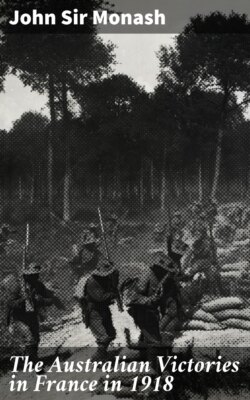Читать книгу The Australian Victories in France in 1918 - John Sir Monash - Страница 7
На сайте Литреса книга снята с продажи.
ОглавлениеThe Australian Corps Commander—with the Generals of his Staff.
The Valley of the Somme—looking East towards Bray, which was then still in enemy hands.
Nothing can be more unstinted than the acknowledgment which the Australian Corps makes of its obligation to the Tank Corps for its powerful assistance throughout the whole of the great offensive. Commencing with the battle of Hamel, a large contingent of Tanks participated in every important "set-piece" engagement which the Corps undertook. The Tanks were organized into Brigades, each of three Battalions, each of three Companies, each of twelve Tanks. During the opening phases, early in August, the Tank contingent comprised a whole Brigade of Mark V. Tanks, a Battalion of Mark V. (Star) Tanks, and a Battalion of fast Armoured Cars; in the later phases, during the assault on the Hindenburg Line, a second Brigade of Mark V. Tanks and a Battalion of Whippets also co-operated.
Such was the formidable array of fighting resources under the direct orders of the Australian Corps Commander, and, together with the five Australian Divisions, formed a fighting organization of great strength and solidarity. It became an instrument for offensive warfare, as has been said by a high authority, which for size and power excelled all Corps organizations which either this or any previous war had produced. It was an instrument which it was a great responsibility, as also a great honour, to wield in the task of shattering the still formidable military power of the enemy. For in the early summer of 1918, that power appeared to be still unimpaired, and still capable of inflicting serious reverses upon the Allied cause.
Early in 1918, owing to the depletion of human material, the Imperial Divisions were reconstituted by a reduction of their Infantry Brigades from a four-battalion to a three-battalion basis, thus reducing the available infantry by twenty-five per cent. But in this reduction, the Australian Divisions during the fighting period shared only to a very small extent. In March the strength of the 15 Brigades of Australian Infantry in the field was still 60 Battalions. The heavy fighting of March and April compelled the extinction of 3 Battalions, one each respectively in the 9th, 12th and 13th Infantry Brigades; but the remaining 57 Battalions of Infantry remained intact until after the close of the actual fighting operations early in October. The Corps was therefore enabled to maintain an additional twelve battalions over and above the then prevailing corresponding Imperial organization.
It was thus the largest of all Army Corps ever organized, in this or any other war, by any of the combatants—the largest both in point of numbers and of military resources of all descriptions, approaching, and in one case exceeding, a full Army command.
But even these great resources and responsibilities were added to, during the course of the operations, by the allocation, at successive times, to the Australian Corps of the 17th Imperial Division, the 32nd Imperial Division and the 27th and 30th American Divisions. Thus, during the closing days of September, 1918, the Corps numbered a total of nearly 200,000 men, exceeding more than fourfold the whole of the British troops under the command of the Duke of Wellington at the Battle of Waterloo.
Of this total about one-half comprised Australian troops, the Heavy Artillery and other Army units attached to the Corps consisting of Imperial troops. The Commanders and Staffs from June, 1918, until the end consisted almost entirely of Australian officers, among whom the following were the senior:
| Corps Commander | Lieut.-General Sir J. Monash, |
| G.C.M.G., K.C.B., V.D. | |
| Corps Chief-of-Staff | Brigadier-General T. A. Blamey, |
| C.M.G., D.S.O. | |
| Corps Artillery Commander | Brigadier-General W. A. Coxen, |
| C.B., C.M.G., D.S.O. | |
| Chief Engineer | Brigadier-General C. H. Foott, |
| C.B., C.M.G. | |
| 1st Div. Commander | Major-General Sir T. W. Glasgow, |
| K.C.B., D.S.O. | |
| General Staff Officer | Lieut.-Colonel A. M. Ross, C.M.G., D.S.O. |
| Chief Admin. Officer | Lieut.-Colonel H. G. Viney, |
| C.M.G., D.S.O. | |
| 2nd Div. Commander | Major-General Sir C. Rosenthal, |
| K.C.B., C.M.G., D.S.O. | |
| General Staff Officer | Lieut.-Colonel C. G. N. Miles, |
| C.M.G., D.S.O. | |
| Chief Admin. Officer | Lieut.-Colonel J. M. A. Durrant, |
| C.M.G., D.S.O. | |
| 3rd Div. Commander | Major-General Sir J. Gellibrand, |
| K.C.B., D.S.O. | |
| General Staff Officer | Lieut.-Colonel C. H. Jess, C.M.G., D.S.O. |
| Chief Admin. Officer | Lieut.-Colonel R. E. Jackson, D.S.O. |
| 4th Div. Commander | Major-General E. G. Sinclair-Maclagan, |
| C.B., D.S.O. | |
| General Staff Officer | Lieut.-Colonel J. D. Lavarack, |
| C.M.G., D.S.O. | |
| Chief Admin. Officer | Lieutenant-Colonel R. Dowse, D.S.O. |
| 5th Div. Commander | Major-General Sir J. J. T. Hobbs, |
| K.C.B., K.C.M.G., V.D. | |
| General Staff Officer | Lieut.-Colonel J. H. Peck, C.M.G., D.S.O. |
| and later | Lieut.-Colonel J. T. McColl, O.B.E., M.C. |
| Chief Admin. Officer | Colonel J. H. Bruche, C.B., C.M.G. |
All the above were Australian Officers, and most of them were of Australian birth. There were also two senior staff officers of the Regular Army, Brigadier-General R. A. Carruthers, C.B., C.M.G., who was Chief of the Administrative Services, and Brigadier-General L. D. Fraser, C.B., C.M.G., who was in immediate command of the Heavy Artillery of the Corps.[2]
